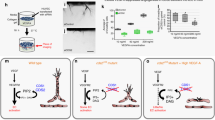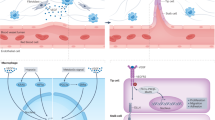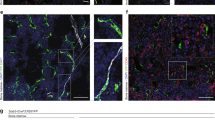Abstract
Vascular endothelial growth factor (VEGF) exerts crucial functions during pathological angiogenesis and normal physiology. We observed increased hematocrit (60–75%) after high-grade inhibition of VEGF by diverse methods, including adenoviral expression of soluble VEGF receptor (VEGFR) ectodomains, recombinant VEGF Trap protein and the VEGFR2-selective antibody DC101. Increased production of red blood cells (erythrocytosis) occurred in both mouse and primate models, and was associated with near-complete neutralization of VEGF corneal micropocket angiogenesis. High-grade inhibition of VEGF induced hepatic synthesis of erythropoietin (Epo, encoded by Epo) >40-fold through a HIF-1α–independent mechanism, in parallel with suppression of renal Epo mRNA. Studies using hepatocyte-specific deletion of the Vegfa gene and hepatocyte–endothelial cell cocultures indicated that blockade of VEGF induced hepatic Epo by interfering with homeostatic VEGFR2-dependent paracrine signaling involving interactions between hepatocytes and endothelial cells. These data indicate that VEGF is a previously unsuspected negative regulator of hepatic Epo synthesis and erythropoiesis and suggest that levels of Epo and erythrocytosis could represent noninvasive surrogate markers for stringent blockade of VEGF in vivo.
NOTE: In the version of this article initially published, the name of one of the authors, Nihar R. Nayak, was misspelled as Nihar R. Niyak. The error has been corrected in the HTML and PDF versions of the article.
This is a preview of subscription content, access via your institution
Access options
Subscribe to this journal
Receive 12 print issues and online access
$209.00 per year
only $17.42 per issue
Buy this article
- Purchase on Springer Link
- Instant access to full article PDF
Prices may be subject to local taxes which are calculated during checkout




Similar content being viewed by others
Change history
06 April 2009
In the version of this article initially published, the name of one of the authors, Nihar R. Nayak, was misspelled as Nihar R. Niyak. The error has been corrected in the HTML and PDF versions of the article.
References
Ferrara, N., Gerber, H.P. & LeCouter, J. The biology of VEGF and its receptors. Nat. Med. 9, 669–676 (2003).
Yancopoulos, G.D. et al. Vascular-specific growth factors and blood vessel formation. Nature 407, 242–248 (2000).
Hurwitz, H. et al. Bevacizumab plus irinotecan, fluorouracil, and leucovorin for metastatic colorectal cancer. N. Engl. J. Med. 350, 2335–2342 (2004).
Konner, J. & Dupont, J. Use of soluble recombinant decoy receptor vascular endothelial growth factor trap (VEGF Trap) to inhibit vascular endothelial growth factor activity. Clin. Colorectal Cancer 2, S81–S85 (2004).
Ferrara, N. et al. Heterozygous embryonic lethality induced by targeted inactivation of the VEGF gene. Nature 380, 439–442 (1996).
Kuo, C.J. et al. Comparative evaluation of the antitumor activity of antiangiogenic proteins delivered by gene transfer. Proc. Natl. Acad. Sci. USA 98, 4605–4610 (2001).
Laird, A.D. et al. SU6668 inhibits Flk-1/KDR and PDGFRbeta in vivo, resulting in rapid apoptosis of tumor vasculature and tumor regression in mice. FASEB J. 16, 681–690 (2002).
Holash, J. et al. VEGF-Trap: a VEGF blocker with potent antitumor effects. Proc. Natl. Acad. Sci. USA 99, 11393–11398 (2002).
Maynard, S.E. et al. Excess placental soluble fms-like tyrosine kinase 1 (sFlt1) may contribute to endothelial dysfunction, hypertension, and proteinuria in preeclampsia. J. Clin. Invest. 111, 649–658 (2003).
Eremina, V. et al. Glomerular-specific alterations of VEGF-A expression lead to distinct congenital and acquired renal diseases. J. Clin. Invest. 111, 707–716 (2003).
Jacobi, J. et al. Discordant effects of a soluble VEGF receptor on wound healing and angiogenesis. Gene Ther. 11, 302–309 (2004).
Zelzer, E. et al. VEGFA is necessary for chondrocyte survival during bone development. Development 131, 2161–2171 (2004).
Levine, R.J. et al. Circulating angiogenic factors and the risk of preeclampsia. N. Engl. J. Med. 350, 672–683 (2004).
Kuo, C.J., Farnebo, E.Y., Becker, C.M. & Folkman, J. VEGF-targeted antiangiogenic gene therapy. in Gene Therapy of Cancer (ed. Lattime, E.) (2002).
Prewett, M. et al. Antivascular endothelial growth factor receptor (fetal liver kinase 1) monoclonal antibody inhibits tumor angiogenesis and growth of several mouse and human tumors. Cancer Res. 59, 5209–5218 (1999).
Fiedler, W. et al. A phase 2 clinical study of SU5416 in patients with refractory acute myeloid leukemia. Blood 102, 2763–2767 (2003).
Wedge, S.R. et al. ZD4190: an orally active inhibitor of vascular endothelial growth factor signaling with broad-spectrum antitumor efficacy. Cancer Res. 60, 970–975 (2000).
Rinaudo, D. & Toniatti, C. Sensitive ELISA for mouse erythropoietin. Biotechniques 29, 218–220 (2000).
Gerber, H.P. et al. VEGF regulates haematopoietic stem cell survival by an internal autocrine loop mechanism. Nature 417, 954–958 (2002).
Ziegler, B.L. et al. KDR receptor: a key marker defining hematopoietic stem cells. Science 285, 1553–1558 (1999).
Ebert, B.L. & Bunn, H.F. Regulation of the erythropoietin gene. Blood 94, 1864–1877 (1999).
Ryan, H.E., Lo, J. & Johnson, R.S. HIF-1 alpha is required for solid tumor formation and embryonic vascularization. EMBO J. 17, 3005–3015 (1998).
Stec, D.E., Davisson, R.L., Haskell, R.E., Davidson, B.L. & Sigmund, C.D. Efficient liver-specific deletion of a floxed human angiotensinogen transgene by adenoviral delivery of Cre recombinase in vivo. J. Biol. Chem. 274, 21285–21290 (1999).
Hegenbarth, S. et al. Liver sinusoidal endothelial cells are not permissive for adenovirus type 5. Hum. Gene Ther. 11, 481–486 (2000).
Tao, N. et al. Sequestration of adenoviral vector by Kupffer cells leads to a nonlinear dose response of transduction in liver. Mol. Ther. 3, 28–35 (2001).
Soriano, P. Generalized lacZ expression with the ROSA26 Cre reporter strain. Nat. Genet. 21, 70–71 (1999).
Michael, M.D. et al. Loss of insulin signaling in hepatocytes leads to severe insulin resistance and progressive hepatic dysfunction. Mol. Cell 6, 87–97 (2000).
Laughlin, K.M. et al. Biodistribution of the nitroimidazole EF5 (2-[2-nitro-1H-imidazol-1-yl]-N-(2,2,3,3,3-pentafluoropropyl) acetamide) in mice bearing subcutaneous EMT6 tumors. J. Pharmacol. Exp. Ther. 277, 1049–1057 (1996).
Cramer, T. et al. HIF-1alpha is essential for myeloid cell-mediated inflammation. Cell 112, 645–657 (2003).
LeCouter, J. et al. Angiogenesis-independent endothelial protection of liver: role of VEGFR-1. Science 299, 890–893 (2003).
Gerber, H.P. et al. VEGF is required for growth and survival in neonatal mice. Development 126, 1149–1159 (1999).
Jakeman, L.B., Winer, J., Bennett, G.L., Altar, C.A. & Ferrara, N. Binding sites for vascular endothelial growth factor are localized on endothelial cells in adult rat tissues. J. Clin. Invest. 89, 244–253 (1992).
Maharaj, A.S., Saint-Geniez, M., Maldonado, A.E. & D'Amore, P.A. Vascular endothelial growth factor localization in the adult. Am. J. Pathol. 168, 639–648 (2006).
Yamane, A. et al. A new communication system between hepatocytes and sinusoidal endothelial cells in liver through vascular endothelial growth factor and Flt tyrosine kinase receptor family (Flt-1 and KDR/Flk-1). Oncogene 9, 2683–2690 (1994).
Mahasreshti, P.J. et al. Intravenous delivery of adenovirus-mediated soluble FLT-1 results in liver toxicity. Clin. Cancer Res. 9, 2701–2710 (2003).
Matsumoto, K., Yoshitomi, H., Rossant, J. & Zaret, K.S. Liver organogenesis promoted by endothelial cells prior to vascular function. Science 294, 559–563 (2001).
Hu, C.J., Wang, L.Y., Chodosh, L.A., Keith, B. & Simon, M.C. Differential roles of hypoxia-inducible factor 1alpha (HIF-1alpha) and HIF-2alpha in hypoxic gene regulation. Mol. Cell. Biol. 23, 9361–9374 (2003).
Warnecke, C. et al. Differentiating the functional role of hypoxia-inducible factor (HIF)-1alpha and HIF-2alpha (EPAS-1) by the use of RNA interference: erythropoietin is a HIF-2alpha target gene in Hep3B and Kelly cells. FASEB J. 18, 1462–1464 (2004).
Wiesener, M.S. et al. Widespread hypoxia-inducible expression of HIF-2alpha in distinct cell populations of different organs. FASEB J. 17, 271–273 (2003).
Rankin, E.B., Tomaszewski, J.E. & Haase, V.H. Renal cyst development in mice with conditional inactivation of the von Hippel-Lindau tumor suppressor. Cancer Res. 66, 2576–2583 (2006).
Hattori, K. et al. Vascular endothelial growth factor and angiopoietin-1 stimulate postnatal hematopoiesis by recruitment of vasculogenic and hematopoietic stem cells. J. Exp. Med. 193, 1005–1014 (2001).
Hattori, K. et al. Placental growth factor reconstitutes hematopoiesis by recruiting VEGFR1(+) stem cells from bone-marrow microenvironment. Nat. Med. 8, 841–849 (2002).
Malik, A.K. et al. Redundant roles of VEGF-B and PlGF during selective VEGF-A blockade in mice. Blood 107, 550–557 (2006).
Lau, S.C., Rosa, D.D. & Jayson, G. Technology evaluation: VEGF Trap (cancer), Regeneron/Sanofi-Aventis. Curr. Opin. Mol. Ther. 5, 493–501 (2005).
Richard, S. et al. Paradoxical secondary polycythemia in von Hippel-Lindau patients treated with anti-vascular endothelial growth factor receptor therapy. Blood 99, 3851–3853 (2002).
Ryan, H.E. et al. Hypoxia-inducible factor-1alpha is a positive factor in solid tumor growth. Cancer Res. 60, 4010–4015 (2000).
Hennequin, L.F. et al. Design and structure-activity relationship of a new class of potent VEGF receptor tyrosine kinase inhibitors. J. Med. Chem. 42, 5369–5389 (1999).
Schipani, E. et al. Hypoxia in cartilage: HIF-1alpha is essential for chondrocyte growth arrest and survival. Genes Dev. 15, 2865–2876 (2001).
Irving, M.G., Roll, F.J., Huang, S. & Bissell, D.M. Characterization and culture of sinusoidal endothelium from normal rat liver: lipoprotein uptake and collagen phenotype. Gastroenterology 87, 1233–1247 (1984).
Acknowledgements
We thank members of the Kuo laboratory for discussion, J. Folkman for support of this project, C. Davis for histopathologic analysis of liver sections, C.-P. Chang for HA-Flt1-His cDNA, A. Patterson for determination of arterial oxygen tension, A. Wagers for demonstrating parabiotic surgeries, M. Socolovsky for murine Epo, J. Zehnder for advice with real-time PCR, C. Koch for EF5 and EF5-specific antibodies, G. Molineux for permission to cite unpublished data and E. Yu for initial assistance. We are indebted to H.-P. Gerber and N. Ferrara for their gift of VegfaloxP/loxP mice, Y.-M. Lin and T. Wandless for synthesis of ZD4190 and the UCSF Liver Center (supported by NIH P30 DK26743) for providing core services. B.Y.Y.T. is a Fonds de la Recherche en Santé du Québec fellow. K.W. is supported by a Medical Scientist Training Program Grant to Stanford University. This work was supported by grants from the US National Institutes of Health (1 R01 CA95654-01 and 1 R01 HL074267-01) and the Department of Defense (DAMD17-02-1-0143) to C.J.K. and funds from Amgen Corporation (to R.J.K.). C.J.K. is a Burroughs Wellcome Foundation Scholar in the Pharmacological Sciences and a Kimmel Foundation Scholar.
Author information
Authors and Affiliations
Contributions
B.Y.Y.T. and K.W. designed and performed experiments and wrote the manuscript. J.S.R. performed animal studies with VEGF Trap protein and edited the manuscript. J. Hoffman performed Epo RT-QPCR. J.Y. and C.C. generated Ad VEGF Trap and Ad KDR-Fc. G.W. assisted on hematocrit and flow cytometry studies. L.M. and S.L.S. analyzed RBC precursors. U.S. performed pathologic analysis. J. Holash and S.J. performed animal studies with VEGF Trap protein. S.K.P. performed studies with VegfaloxP/loxP mice and RT-QPCR of hypoxic genes. R.S.J. and J.A.G. provided expertise in liver physiology. F.A.K. designed and performed RBC mass analysis. G.D.Y. supervised VEGF Trap studies. R.C.M. supervised adenoviral construction and production. C.J.K. was principal investigator, designed and conceptualized the study, analyzed and interpreted all data, and drafted and edited the manuscript.
Corresponding author
Ethics declarations
Competing interests
The authors declare no competing financial interests.
Supplementary information
Supplementary Fig. 1
Elevation of erythroid parameters in sVEGFR-treated mice (PDF 139 kb)
Supplementary Fig. 2
Stimulation of Epo mRNA production in hepatocytes of Ad-Flt1treated mice as determined by in situ hybridization. (PDF 519 kb)
Supplementary Fig. 3
Soluble Flt1 ectodomain induces hepatic Epo expression in the absence of direct liver infection in parabiotic mice. (PDF 117 kb)
Supplementary Fig. 4
Transient increase of Epo mRNA in hypoxic kidneys or livers. (PDF 60 kb)
Supplementary Fig. 5
Ad-Cremediated excision of the loxP-flanked stop cassette in ROSA26-LacZ mice allows expression of the lacZ gene. (PDF 2327 kb)
Supplementary Fig. 6
EF5 detection of hypoxia in tumors and Ad-Flt1treated liver. (PDF 206 kb)
Supplementary Fig. 7
Ad-Flt1 and Ad-Flk1-Fctreated livers do not show evidence of hemorrhage, necrosis or ischemic tissue damage. (PDF 818 kb)
Supplementary Fig. 8
Epo mRNA is selectively elevated in hepatocyte coculture with LSECs but not other endothelial cell types or fibroblasts. (PDF 117 kb)
Supplementary Fig. 9
Comparative inhibition of VEGF-stimulated corneal-micropocket angiogenesis by Ad-Flt1, ZD4190 and rVEGF Trap. (PDF 490 kb)
Supplementary Table 1
Elevation of Ter119+CD45 erythroid precursors by VEGF blockade. (PDF 58 kb)
Supplementary Table 2
Assessment of hydration and oxygenation status following VEGF inhibition. (PDF 117 kb)
Rights and permissions
About this article
Cite this article
Tam, B., Wei, K., Rudge, J. et al. VEGF modulates erythropoiesis through regulation of adult hepatic erythropoietin synthesis. Nat Med 12, 793–800 (2006). https://doi.org/10.1038/nm1428
Received:
Accepted:
Published:
Issue Date:
DOI: https://doi.org/10.1038/nm1428
This article is cited by
-
Progressive erythrocytosis under lenvatinib treatment in patients with advanced hepatocellular carcinoma
Cancer Chemotherapy and Pharmacology (2023)
-
Protective role of estrogen against excessive erythrocytosis in Monge’s disease
Experimental & Molecular Medicine (2021)
-
HIF-1α promotes the migration and invasion of hepatocellular carcinoma cells via the IL-8–NF-κB axis
Cellular & Molecular Biology Letters (2018)
-
Hepatic dysfunction and thrombocytopenia induced by excess sFlt1 in mice lacking endothelial nitric oxide synthase
Scientific Reports (2018)
-
Haemoglobin level increase as an efficacy biomarker during axitinib treatment for metastatic renal cell carcinoma: a retrospective study
BMC Cancer (2017)



